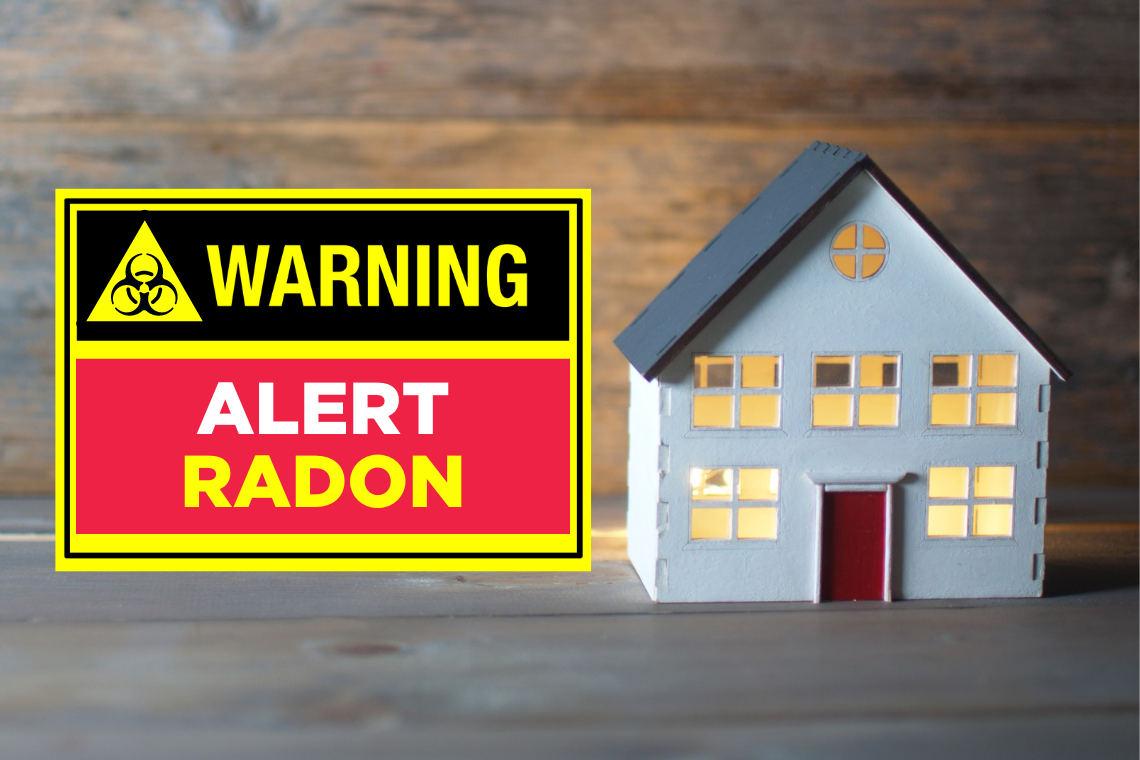
Nov. 01, 2022 | CREB
Radon awareness month is here
Radon is often not talked about as the effects aren't immediate, but if it isn't addressed, it can ultimately lead to premature death.
To create awareness about National Radon Action Month this November, we sat down with subject matter expert, Dorothy Bewernick from Great West Radon to answer all your radon questions, including how it affects your health and the health of your family and how you can protect yourself when it comes to exposure.
CREB®: What is radon?
Dorothy Bewernick: Radon gas is a colorless, odorless, tasteless, and radioactive gas that is the leading cause of lung cancer in non-smokers in Canada.
Radon gas is a type 1 carcinogen in the same category as tobacco and asbestos. It comes from the breakdown of naturally occurring uranium in the ground and enters our homes through cracks, voids, and gaps in our foundations and various ground penetrations such as sump pits or floor drains, etc.
CREB®: Why is radon a concern to homeowners?
Dorothy Bewernick Radon gas is present everywhere, even outdoors. The reason why radon gas can become harmful is that it gathers to unnaturally high and cancer-causing levels indoors.
Radon gas emits alpha particle radiation which severely damages our DNA which our bodies struggle to repair without introducing genetic errors resulting in the formation of cancer. It primarily triggers the formation of lung cancer which is the number one cause of cancer death in Canada resulting in ~3200 deaths per year.
Children and pets are at higher risk than adults due to their high respiratory rates and their rapidly developing cells during growth. The longer the person has been exposed to high levels of Radon the higher their cancer risk.
CREB®: What complications can arise with radon exposure?
Dorothy Bewernick: The harmful effects of radon gas are unfortunately nothing that can be immediately noticed in a person’s overall health. The number one complication of living in a high Radon environment is a long-term lung cancer diagnosis. Unfortunately, symptoms of lung cancer normally only present themselves in later stage diagnosis. These symptoms are persistent coughing, chest pain, shortness of breath, coughing up blood, fatigue and unexplained weight loss.
CREB®: Is Radon found in old and new homes?
Dorthy Bewernick: Radon gas is found in all homes. Contrary to belief, newer homes built after 1992 tend to have almost 32 per cent higher levels than homes built prior to 1992. Unfortunately, the same measures that allow us to increase our home’s heat efficiencies are also tending to trap radon gas at extremely dangerous levels. This is not to say that older homes are unable to have high levels. Some home’s high radon problems are just a product of large uranium deposits in the ground beneath the home which is an unavoidable circumstance that can only be fixed through radon mitigation.
CREB®: Should renters and homeowners test for radon?
Dorthy Bewernick: Anyone that lives in a home should test for radon.
Landlords are required by law to provide their tenants with a safe space to rent; radon can be included in this measure. We’ve worked with many landlords that are happy to ensure their tenants are living in safe and healthy home.
Adding radon testing to your routine home maintenance list is a great way to ensure your and your family’s long term lung health.
CREB®: How do you test for radon?
Dorothy Bewernick: Radon testing can be done in a couple of ways but the key regardless of method is to do a long-term average during the “heating season” of October to April.
Radon fluctuates quite drastically from day to day so ensuring you are doing a proper long-term test is the number one way to guarantee successful testing results.
You can choose to do a long-term test kit – they cost around $50 and require being left in the lowest lived-in area of your home for a minimum of 90 days. After this time the kit should be put back in the return envelope it came with and sent to the lab for analysis. This normally takes two to four weeks to complete and get your results e-mailed to you.
The alternative to this is digitally monitoring for radon. There are a variety of digital radon monitors on the market varying in price due to the features they offer. These digital monitors are a great tool if users operate them according to instructions. The most important thing to keep in mind is to leave the device in one place for the full 90 days to get the proper average, as well as putting the device in the appropriate place such as a basement bedroom nightstand or TV console in an entertainment area, etc.
CREB®: How often should you test for radon?
Dorthy Bewernick: Radon testing should be done two years after mitigation and then every five years after that. This ensures the efficacy of your radon mitigation system.
In terms of retesting a home that does not have a radon mitigation system, the recommendation is after any extensive renovations, particularly replacing old windows or measures that aid in overall home efficiency. Testing for radon with a digital monitor would allow you to continuously monitor the radon levels in your home, long term test kits do not allow this as they are a one-time-use product.
One thing to note is that radon levels can change drastically if any major ground disturbance has occurred within 5 kilometers of your home. So, if you live in an area with new developments happening or extensive road construction etc. it would be a good idea to re-test your home if you haven’t done so in a while.
CREB®: Can you tell if a home has tested for Radon in the past?
Dorthy Bewernick: If a home has a Radon mitigation system, this will indicate that the homeowners had the home tested and fixed their high radon problem. A properly mitigated home is a safer home for all occupants. If Radon levels in the home are over 200 Bq/m3 the health risks become so significant that it becomes a material latent defect. So, if a home has been tested and put on the market with high levels the homeowner is legally obligated to disclose it. If the home has no mitigation system, there is no discernable way of being able to tell whether it has ever been tested outside of asking the homeowners themselves.
CREB®: What can a homeowner do if radon is detected in their home?
Dorthy Bewernick: High levels of radon gas in a home is a fixable issue! C-NRPP-certified mitigation services performed by experienced professionals can decrease the radon levels in your home by up to 95 per cent.
The service itself is completed in one day (in most homes) and costs on average between $2000-$2500 as per Health Canada Standards. The first step would be to engage a C-NRPP-certified contractor to obtain a quote, and ensure you have the scope of work that will be performed in your home as well as an agreement in place to protect yourself as a homeowner.
CREB®: How do you get rid of Radon in the home?
Dorthy Bewernick: There are a variety of methods for radon reduction in a home but only one is the most effective. Sealing cracks and voids in your basement slab are effective in decreasing the radon levels in your home by about 13 per cent. Increasing home ventilation or installing an HRV system only works to decrease levels by about 25-50 per cent.
Hiring a C-NRPP-certified professional to install a radon mitigation system can lower your levels by 90 per cent or more. Fresh air is a great way to temporarily decrease radon levels in the home which is why radon levels in homes tend to be lowest in the spring and summer months when we happily open our doors and windows to allow for fresh air. This becomes an issue in the wintertime when the weather outside is too cold to allow that to happen regularly or for extended periods of time.
CREB®: Any other tidbits of information you feel people should know about Radon?
Dorthy Bewernick: Radon testing results can be confusing, but we have a very simple statement about when people should act.
Scientifically speaking there is no safe amount of radon so the lower the levels, the less your risk.
The World Health Organization suggests acting at 100 Bq/m3 – this is the point at which the long-term lung cancer risk significantly increases. Acting at this level is more urgent for those with babies or young children in the household as well as pets as their respiratory rates are higher and they have rapidly developing cells that are more susceptible to DNA level damage from radon gas.
Health Canada has a maximum allowable indoor level threshold of 200 Bq/M3. This is the highest you should let your levels get to before taking action to reduce the radon levels in your home.
There are some misconceptions about homes with radon rough-ins already being mitigated. This applies to homes built after 2015 when the building code started mandating radon rough-ins as part of the construction.
We like to make sure that homeowners are aware that this does not mean that the radon mitigation system is already installed in the home, but just like a bathroom rough-in in an undeveloped basement, these measures are put in place to allow for a simpler installation once you have decided to proceed with mitigation services.
Testing a brand-new home is still a great idea as, despite all these construction measures for radon reduction, newer homes still often have high radon concentrations.
For additional resources visit the Health Canada Website.
About Great West Radon
Great West Radon is a family-owned and operated company Calgary-based company. Please visit their website to learn more.
Tagged: Radon




